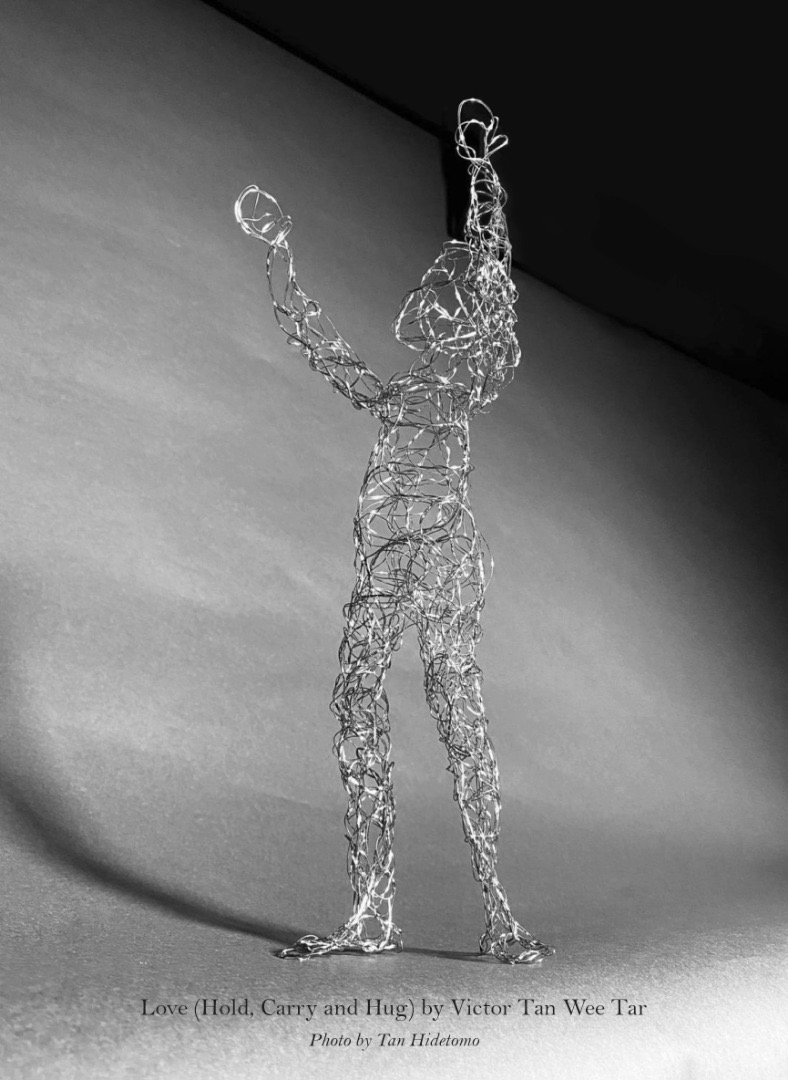Love (Hold, Carry and Hug) 爱 (拥抱)
Dohjidai Gallery of Art, Kyoto, Japan, 17 – 22 Mar, 2020 – Cancelled
愛(掴み、抱き上げ、抱きしめる)
世界保健機関のレポートには、「毎年、80万人近くの人が自らの命を絶っている」とあります。所得の高い国々では、自殺と精神障害(特にうつ病とアルコール使用障害)のつながりが既知の事実として受け止められていますが、実は自殺の多くは金銭的な問題や人間関係の崩壊、慢性的な痛みや病気といった生活上のストレスに上手く付き合っていく能力が破綻してしまった時、そのような困難な時に衝動的に起こるのです。そして、紛争、災害、暴力、虐待、喪失、孤独感を経験することは自殺行為と強い関連性があるのです。
今日の世界で私たちが必要としているもの、あるいは足りないと感じているものは、単に食べ物や避難所といったものだけではなくて、誰かが気にかけてくれている、誰かが愛してくれている、みんな独りぼっちじゃなくて助けを求めた時に受け止めてもらえる、といった感情なのではないでしょうか。おそらく、愛のある「触れる」経験が今の世界に足りないものなのです。
触れる経験がなかったとしたら?200年前、フランス人の科学者が森を駆け回っている人間によく似た生物を発見しました。捕まえてみると、なんと幼児期の大半を野生の森で走り回って育った11歳の子どもだったのです。その子ども「ビクター」は最初、みんなに知的障害児と認定されました。フランス人の内科医と精神科医はその後、人間味のある生身の触れ合いが乏しかったため、社会的および発達的能力の発達が遅れたと結論付けました。
目に見えない知覚の基本的な形である「触れる」経験は、私たちの感覚的経験のほぼすべてにおいて重要な役割を果たしています。「触れる」経験は、社会全体を支えているものですが、不安を軽くしてくれて、痛みを和らげてくれるのではないかという証拠だってあります。でも「触れる」経験が実際に私たちの脳の組織を形作っているものなのでしょうか。研究によると、特に幼児期の「触れる」経験が実際の脳の発達を形作ることが明らかになっています。しかし「触れる」経験は脳の発達以上に重要なのです。抱っこされず、十分に抱きしめられられずに育った赤ちゃんは、成長を止めてしまうことだってあるのです。そして、この状態がずっと続くと、死んでしまうことだってあり得るのです。乳児の死亡率が約30~40%だったルーマニアのある孤児院で、その理由を解明しようとしていた研究者がこのことを発見しました。そうです、ベビーベッドでひしめく広く白い部屋の中に孤児が押しやられて暮らしていたら、このような心理社会的剥奪の極端なケースだって起こる可能性があるのです。孤児たちは食べ物が与えられ、おしめも替えてもらえていましたが、それ以外は無視されたのです。
非言語コミュニケーション能力を調べることはなにも今に始まった新しい心理的課題ではありません。姿勢、動き、そして表情が示す複雑な感情と求めているものについて、研究者たちは昔から研究に取り組んできました。一連の研究の中で、心理学者のマシュー・ハーテンスタイン(Mattew Hertenstein)氏は、ボランティアの人々にリストにある感情を目隠しされた見知らぬ人に触れるだけで伝えてもらおうとしました。多くの参加者たちがこの実験のことを心配していました。「今の社会は触れることに恐怖心を抱いている社会なのです。見知らぬ人に触れること、友人にさえ触れることに慣れていないのです。」とハーテンスタイン氏は言います。
作品の中で、視覚芸術家のビクター・タン(Victor Tan)は、掴み、抱き上げ、抱きしめるといった触れる行為に関連する感覚や感情をじっくり掘り下げています。子どもの姿をしたたくさんのワイヤー彫刻が空間を埋め尽くします。ぜひ近づいて赤ちゃんの彫刻を掴んで、抱き上げ、抱きしめてみてください。
In a report by WHO, “every year close to 800 000 people take their own life. While the link between suicide and mental disorders (in particular, depression and alcohol use disorders) is well established in high-income countries, many suicides happen impulsively in moments of crisis with a breakdown in the ability to deal with life stresses, such as financial problems, relationship break-up or chronic pain and illness. In addition, experiencing conflict, disaster, violence, abuse, or loss and a sense of isolation are strongly associated with suicidal behaviour”
It makes me wonder if what we need or lack in today’s world is not just food and shelter but to feel that someone cares, that someone loves, that we are all not alone and will not be rejected when we reach out for help. Perhaps that loving “touch” is what is missing in today’s world.
What can absence of touch lead to? Two hundred years ago, French scientists spotted a creature resembling a human running through the forests. Once captured, they determined he was 11 years old and had run wild in the forests for much of his childhood. Originally the child, “Victor,” was determined to be an idiot; French physicians and psychiatrists eventually concluded he had been deprived of human physical touch, which had retarded his social and developmental capacities.
Touch, as a fundamental form of non-visual perception, plays a crucial role in nearly all our sensory experiences. Touch underpins our social world and, evidence even suggests it may help to reduce anxiety and relief pains. But can touch shape the actual organisation of our brains? Research has revealed that experiences with touch – especially in infancy – do indeed shape brain development. But touch is even more vital than brain development. Babies who are not held, nuzzled, and hugged enough can stop growing, and if the situation lasts long enough, even die. Researchers discovered this when trying to figure out why some orphanages in Romania had infant mortality rates around 30-40%. Yes, it’s possible that these are extreme cases of psychosocial deprivation in where these orphans lived in large white rooms crowded with cribs. They were fed and changed but otherwise ignored.
Probing our ability to communicate nonverbally is also hardly a new psychological task; researchers have long documented the complex emotions and desires that our posture, motions, and expressions reveal. In a series of studies, psychologist Matthew Hertenstein had volunteers attempt to communicate a list of emotions to a blindfolded stranger solely through touch. Many participants were apprehensive about the experiment. “This is a touch-phobic society,” he says. “We’re not used to touching strangers, or even our friends, necessarily.”
In this work by Visual Artist Victor Tan, he delves into the sensations and feelings associated with the act of touch. Multiple wired sculptures of children will occupy the space. Audience are are encouraged to come forward to hold, carry and hug the baby sculpture.
世界卫生组织的一份报告统计,“每年有近 80 万人结束自己的生命。虽然自杀与精神障碍(特别是抑郁症和酗酒障碍)之间的联系在高收入国家已得到充分证实,但许多自杀行为都是在危机时刻冲动发生的,因为应对生活压力(例如财务问题,关系破裂或慢性疼痛和疾病)的能力崩溃了。此外,经历冲突、灾难、暴力、虐待或损失以及孤立感与自杀行为密切相关”
这使我好奇,当今的世界里我们需要或缺乏的不仅仅是食物和住所,而是感到有人关心、有人爱、我们并不孤单,当我们寻求帮助时不会被拒绝。也许当今世界正缺少这种爱的“感触”。
缺乏触摸会有什么样的影响? 200年前,法国科学家发现了一种类似人类的生物在森林中奔跑。被捕后,他们确定他今年 11 岁,童年的大部分时间都在森林里狂奔。最初,这个孩子“维克多”被认定是个白痴;法国医生和精神病学家最终得出结论,他被剥夺了人类的身体接触,这阻碍了他的社交和发展能力。
触觉作为非视觉感知的基本形式,在我们几乎所有的感官体验中都起着至关重要的作用。触摸是我们社交世界的基础,有证据显示它可能有助于减少焦虑和缓解疼痛。但触摸能塑造我们大脑的实际组织吗?研究表明,触摸的经历——尤其是在婴儿期——确实会影响大脑的发育。但触觉比大脑发育更重要。没有得到足够的拥抱、抚摸和拥抱的婴儿可能会停止生长,如果这种情况持续足够长的时间,甚至会死亡。研究人员在试图弄清楚为什么罗马尼亚一些孤儿院的婴儿死亡率约为 30-40% 时发现了这一点。是的,这些孤儿可能住在挤满婴儿床的白色大房间里,这是社会心理剥夺的极端案例。他们被喂食和换衣服,但在其他方面的需要却被忽视了。
探索我们的非语言交流能力也不是什么新的心理学任务。研究人员长期以来一直记录着我们的姿势、动作和表情所揭示的复杂情绪和欲望。在一系列研究中,心理学家马修·赫滕斯坦让志愿者尝试仅通过触摸向蒙住眼睛的陌生人传达一系列情绪。许多参与者对这个实验感到忧虑。 “我们生活在一个恐惧触摸的社会,”他说。 “我们不一定习惯于触摸陌生人,甚至是我们的朋友。”
在视觉艺术家陈为达的作品中,他深入研究了与触摸行为相关的感觉和感受。展览空间内会有多个用铁线雕塑的儿童雕塑。我们鼓励观众上前触碰并拥抱婴儿雕塑。

